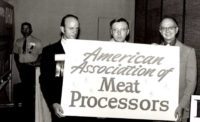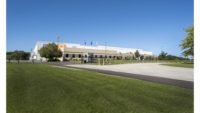AAMP
A look back: AAMP celebrates 80th anniversary
The American Association of Meat Processors (AAMP) recently celebrated 80 years of service to the meat industry during the 80th American Convention of Meat Processors and Suppliers’ Exhibition, July 25-27, in Mobile, Ala.






The father of frozen food
In 1912, Clarence Birdseye started a five-year journey around the Labrador waters in which he traveled by dog sled collecting furs for sale. During this period, Birdseye noted that duck and caribou frozen in the extreme cold of midwinter were better than those frozen in the spring or fall. He noticed how easily food was preserved in the arctic climate. He watched the Eskimos’ simple quick-freeze methods, a process by which items are frozen at such a speed that only small ice crystals are able to form, and noted that quickly frozen fish retained flavor and texture better than fish frozen slowly.
Birdseye entered the wholesale fish business in 1922 and experimented with the process of quick freezing food that he had learned while in Labrador. In 1923, with an investment of $7 for an electric fan, buckets of brine, and cakes of ice, Birdseye invented and later perfected a system of packing fresh food into waxed cardboard boxes and flash-freezing them under high pressure. In 1926, he had developed a quick-freeze double-belt machine weighing 20 tons. It was later transformed into a more transportable multiple-plate freezer, which was to become widely used in the frozen food industry.
He became known as the “father of frozen food” and was a man of extraordinary vision, insatiable curiosity, and enormous persistence. Birdseye made two major contributions to the concept of freezing food — the importance of freezing food so rapidly that there would be no damage to its cellular structure (affecting taste, texture, and appearance), and freezing food in a package that could be sold directly to the consumer.
Cold storage lockers
In the mid 1930’s, builders of locker plants and locker plant equipment organized the Frozen Food Locker Manufacturers. By the late 1930’s, the Frozen Food Locker Manufacturers was eventually known as Frozen Food Locker Institute (FFLI) – Supplier Group. In 1937, Iowa organized the first state association of locker plant operators, and other states soon followed. In 1939, leaders of a number of state locker associations met in Des Moines, Iowa, and organized the National Frozen Food Locker Association (NFFLA) – Operator Group.
This was a model cold storage locker exhibit plant on the Iowa State Fair Grounds held in Des Moines, Iowa in 1939. A variety of marketing strategies were developed to entice customers not to abandon their local cold storage locker establishment.
Cold storage locker establishments were forced to diversify their business to stay in business. Chilling and aging carcasses under controlled temperature maintained the quality of the meat as well as decreased spoilage that might occur under less than ideal conditions, Meat cutting services insured uniform thickness any way the customer requested. Wrapping services and fast freezing technology helped maintain the quality of the finished product. Curing and smoking services were also offered under controlled temperatures and sanitary conditions and performed by experts in the meat industry. Delivery services were offered by some cold storage locker establishments to maintain their customer base.
Annual convention history
In December of 1939, the first annual convention of the National Frozen Food Locker Association was held in Des Moines, Iowa. Topics discussed at the convention included plastic packaging materials, meat cutting procedures, and the economic effects of locker services. A trade show was also held in conjunction with the convention. Exhibitors displayed locker storage equipment, refrigeration equipment, packaging materials, and meat processing equipment.
In 1942, the association totaled over 3,500 members. In 1944, a verbal agreement was entered into between the suppliers (Frozen Food Locker Institute) and the locker operators (National Frozen Food Locker Association) to jointly sponsor the annual convention and exhibition in 1947. Al Guggedahl, executive Director of the National Frozen Food Locker Association, resigned in 1947 for health reasons. Keith Bauder, a prominent and successful locker operator from Fort Plain, New York, accepted the appointment as the new executive secretary for $1, per year, with the understanding that the headquarters would eventually be moved from Des Moines, Iowa to Chicago, Ill. and that George Schiemer would head up the office staff. The National Frozen Food Locker Association headquarters moved to Fort Plain, New York. Meat processing clinics were held in conjunction with the 8th annual convention in 1947. The sessions consisted of meat fabrication demonstrations, poultry processing demonstrations, slaughtering demonstrations, and curing demonstrations.
In 1948 the National Frozen Food Locker Association headquarters moved to Chicago, Ill. In 1949, two separate conventions were held in Chicago, Ill. The National Frozen Food Locker Association met in September and S.T. Warrington was hired as the full-time executive secretary for the association. The Frozen Food Locker Institute met in October where Albert Todoroff was named the executive secretary of the association.
First annual ham show
The first annual Ham Show was held in conjunction with the 10th Annual Convention of the National Frozen Food Locker Association. A total of 65 hams were entered and judged in four classes. The Annual Ham Show continued until 1953.
In 1950 the National Frozen Food Locker Association and the Frozen Food Locker Institute agreed to jointly sponsor the national convention in October at the Palmer House in Chicago, Ill.
At the 1950 convention, a negotiating committee was formed consisting of four members from each group to bring about a resolution of the conflict between the two groups. The result? The two associations merged to become the National Frozen Food Locker Institute (NFFLI). The news of this merger was announced at the convention and released in the publication Locker Management and Locker Operator.
In January of 1951, the board of directors of the National Frozen Food Locker Institute hired Robert L. Madeira as the new executive secretary. The NFFLI headquarters moved from Chicago, Ill. to Elizabethtown, Pa. Although the welcome mat was always out, only a few operators had the opportunity to drop in at the 113 North Market Street headquarters. The Institute staff consisted of four full-time employees, including Madeira.
At the 15th Annual Convention in1954, the Annual Ham Show changed its name to the National Ham Show. The National Ham Show continued until 1965. In 1955 the NFFLI changed its name to the National Institute of Locker & Freezer Provisioners (NILFP). The name change was more representative to the work performed by the operators.
In 1956, the NILFP moved to a new location at 224 East High Street in Elizabethtown, Pa. At the 27th Annual Convention in 1966, the National Ham Show changed its name to the National Ham & Bacon Show, which continued until 1968.
The birth of the American Association of Meat Processors
At the 29th Annual Convention in 1968, the National Ham & Bacon Show changed its name to the National Ham, Bacon & Sausage Show. The name change represented the variety of products produced by its membership. The National Ham, Bacon & Sausage Show continued until 1975. At the 34th Annual Convention in 1973, the membership unanimously voted to change the official name to the American Association of Meat Processors (AAMP) and adopt a new logo.
In 1974, Stephen F. Krut was hired as director of public relations for AAMP. At the 37th Annual Convention in 1976, the National Ham & Bacon Show changed its name to the American Cured Meat Championships (ACMC). This name change increased the variety of products that could be entered and judged.
In 1981, Madeira stepped down as executive director and Krut was appointed as the new executive director of AAMP. Madeira was appointed as Executive Director Emeritus, retiring on January 1, 1986. In the spring of 1986, the AAMP headquarters was remodeled on 224 East High Street in Elizabethtown, Pa.
On November 3, 1989, ground was officially broken for the new home of AAMP. The building project was considered, developed and approved by AAMP’s Long Range Planning Committee, Building and Executive Committees and the association’s board of directors. The new building was developed on a 5.26-acre site in an undeveloped area of Elizabethtown, Pa. The extra acreage was purchased for future development. The ground floor measured about 10,000 square feet and the lower level was developed to lease to outside tenants to help AAMP pay the mortgage and to leave room for expansion of AAMP, if needed.
The development of the new AAMP building continued throughout the winter and was formally dedicated on October 28, 1990. Donations were acquired throughout the development process to subsidize a majority of the costs. The mortgage was paid off January 9, 2001. In the year 2000, the first ever meat industry scholarship was awarded. AAMP received over $45,000 in cash and pledges.
Leadership changes
In 2003, Jay Wenther was hired as director of science and technology. In 2004, Wenther was promoted to assistant executive director. In 2006, Krut stepped down after over 32 years with the association. Wenther assumed the role of AAMP executive director. In 2013, Wenther stepped down for another position in the meat industry. In 2013, Marty Manion was hired as AAMP executive director. In 2015, Manion stepped down for another association position in Naples, Florida.
In 2015 at the 76th Annual Convention in Springfield, Ill, the membership voted to change the association’s logo. The new logo launched September 1, 2015.
AAMP outreach specialist Chris Young was appointed the new executive director in 2015 and continues to lead the association today.
“Through the decades, AAMP has been led by board of directors and professional staff who are committed to maximizing the success of the meat industry and focused on providing value to retailer/supplier relationship,” said Young. “We are proud to serve the industry and appreciate the continued support from our members. We look forward to many more years of being the voice of the meat industry.”
Looking for a reprint of this article?
From high-res PDFs to custom plaques, order your copy today!








